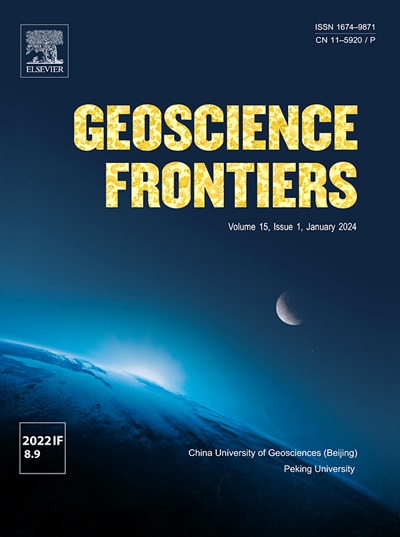CH4 and CO2 emissions and dissolved carbon exporting in rivers on the upper Lanzhou section of the Yellow River, China
IF 8.9
1区 地球科学
Q1 GEOSCIENCES, MULTIDISCIPLINARY
引用次数: 0
Abstract
The Yellow River (YR), China’s second-longest river, remains understudied regarding its greenhouse gases (GHGs) emissions, particularly the impacts of urban drainage ditches and wastewater treatment facilities on regional GHGs dynamics. This study investigated methane (CH4) and carbon dioxide (CO2) concentrations, fluxes and stable carbon isotopes (δ13C-CH4 and δ13C-CO2) across six main stream, three ditches, and one wastewater treatment site along the upper Lanzhou section of the YR, spanning from the urban entrance (36.176°N, 103.449°E) to the exit of Lanzhou city (36.056°N, 104.020°E). Measured CH4 diffusion fluxes in mainstem sites ranged from 0.01 to 2.58 mmol·m−2·d−1 (mean: 0.36 mmol·m−2·d−1), while ebullitive fluxes (gas bubbles) ranged from 0.01 to 18.89 mmol·m−2·d−1 (mean: 0.90 mmol·m−2·d−1). CO2 diffusion fluxes varied between 9.16–92.80 mmol·m−2·d−1 (averaged: 39.11 mmol·m−2·d−1) at these locations. Ebullition (bubble) fluxes accounted for 53.1% ± 22.4% (range: 9.0% to 98.4%) to total CH4 emissions (diffusion plus ebullition), with peak fluxes occurring during summer, indicating its significance as a CH4 transport mechanism. Notably, both diffusion CH4 and CO2 fluxes and ebullitive CH4 rates at ditch sites substantially exceeded those in mainstream reaches. The lowest CH4 and highest CO2 concentrations were observed at a wastewater treatment site, likely resulting from the removal of high organic loads. Acetoclastic methanogenesis—the process converting acetate-derived methyl groups to CH4—was identified as the dominant production pathway in both mainstream and ditch environments. CH4 and CO2 flux magnitudes in the upper YR (Lanzhou section) were comparable to those observed in subtropical Yangtze River tributaries. These results demonstrate that anthropogenic influences significantly enhance CO2/CH4 emissions, and the lateral exports of dissolved carbon (DIC and DOC) in the main stream site was quantified., which cannot be overlooked. The findings emphasize the critical need to account for pronounced spatiotemporal variations in arid-region GHG fluxes to improve basin-scale estimates for the YR.

黄河兰州上游河流CH4、CO2排放及溶解碳输出
中国第二大河黄河(YR)的温室气体(ghg)排放,特别是城市排水沟渠和污水处理设施对区域温室气体动态的影响仍未得到充分研究。本文研究了从兰州市入口(36.176°N, 103.449°E)到兰州市出口(36.056°N, 104.020°E),沿兰州上游河段6条干流、3条沟渠和1个污水处理场的甲烷(CH4)和二氧化碳(CO2)浓度、通量和稳定碳同位素(δ13C-CH4和δ13C-CO2)。CH4在主要部位的扩散通量为0.01 ~ 2.58 mmol·m−2·d−1(平均值0.36 mmol·m−2·d−1),沸腾通量(气泡)为0.01 ~ 18.89 mmol·m−2·d−1(平均值0.90 mmol·m−2·d−1)。CO2扩散通量在9.16 ~ 92.80 mmol·m−2·d−1之间变化(平均为39.11 mmol·m−2·d−1)。气泡(冒泡)通量占CH4(扩散+冒泡)总排放量的53.1%±22.4%(范围9.0% ~ 98.4%),峰值出现在夏季,表明其作为CH4输运机制的重要意义。值得注意的是,沟渠站点的扩散CH4和CO2通量以及沸腾CH4速率均大大超过主流河段。在废水处理场观察到最低的CH4和最高的CO2浓度,可能是由于去除了高有机负荷。在主流和沟渠环境中,丙酮裂解产甲烷(将醋酸酯衍生的甲基转化为ch4的过程)被认为是主要的生产途径。上游(兰州段)的CH4和CO2通量与亚热带长江支流的CH4和CO2通量相当。结果表明,人为影响显著增加了干流站点CO2/CH4排放,并量化了干流站点溶解碳(DIC和DOC)的侧向输出。,这一点不容忽视。研究结果强调,迫切需要考虑干旱地区温室气体通量的明显时空变化,以改进对年的流域尺度估算。
本文章由计算机程序翻译,如有差异,请以英文原文为准。
求助全文
约1分钟内获得全文
求助全文
来源期刊

Geoscience frontiers
Earth and Planetary Sciences-General Earth and Planetary Sciences
CiteScore
17.80
自引率
3.40%
发文量
147
审稿时长
35 days
期刊介绍:
Geoscience Frontiers (GSF) is the Journal of China University of Geosciences (Beijing) and Peking University. It publishes peer-reviewed research articles and reviews in interdisciplinary fields of Earth and Planetary Sciences. GSF covers various research areas including petrology and geochemistry, lithospheric architecture and mantle dynamics, global tectonics, economic geology and fuel exploration, geophysics, stratigraphy and paleontology, environmental and engineering geology, astrogeology, and the nexus of resources-energy-emissions-climate under Sustainable Development Goals. The journal aims to bridge innovative, provocative, and challenging concepts and models in these fields, providing insights on correlations and evolution.
 求助内容:
求助内容: 应助结果提醒方式:
应助结果提醒方式:


